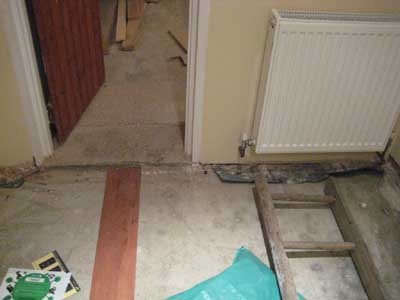Now, please bear with me as I may take some time to get my point across being a compete newcomer to DIY.
I have also receive so much contradicting info from so called "tradesmen" it's unbelievable, so I would really appreciate the some advice on the following situation.
Well, basically the house is circa 1870 standard end terrace Victorian. It has had an extension about 50 years ago and that is the problem room as the flooring was laid without any DPM under the existing concrete floor, so there are some rising damp issues (I think).
To add to this, when we bought the house about 6 months ago the existing felt roof (on the extension) had a gaping hole that was letting rain water run down the inside of the walls and then on to the floor. At the time there was a engineered solid wood nailed to batons.
As you will see from the below photo, the room is all but finished with the exception of the floor. The room was actually a bare shell (back to brick) and after consulting various people, we were advised to run a DPM sheet up the walls to about 1m, and then the walls were battened and celotexed accordingly. The DPM also covered the floor so that it acted like a type of bath, but to keep the water from getting to the walls and floors.



Our intention was to lay a floating engineered wood floor (on top of underlay) but after the flooring guy came round, he said there was a lot of moisture under the sheet as it was making the floor sweat. He wasn't keen on laying a floor as it was, and even said that if we laid a liquid DPM with an additional plastic DPM on top, then the water would probably pass through both DPM layers.
The moisture readings taken at the time were 120 and 85, although the 120 reading was due to fresh concrete having recently been laid to level part of the room out.
Clearly I would like to have wooden floors but I have been recommended to lay tiles instead. So out comes the tiling man.....
The tiling man, although recommended by a family friend, hasn't had much experience on damp floors so doesn't know if he can get an adhesive to stick to a liquid DPM. He has got back to me tonight and confirmed that he isn't aware of such a product.
So this leaves me in a bit of a bother. Do you think that if I laid a wood flooring on top of a liquid dpm and further plastic sheet (belt and braces approach), then the floor would be ok? Just how good are these liquid dpm's at keeping the water out. The floor isn't that wet after all, as now that I have removed the plastic dpm covering the floor, the floor has tried out to the touch.
The other alternative is to lay tiles, but do you think a dpm is necessary, and is it possible to get the tile adhesive to adhere to the liquid DPM?
I can't lay another screed as there is only just over an inch to the bottom of the door frame. Oh, and the floor is not moldy, just has 20 odd years of dirt and dust on it.
I really hope someone can help me out on this!
Many thanks in advance
Graham


